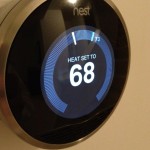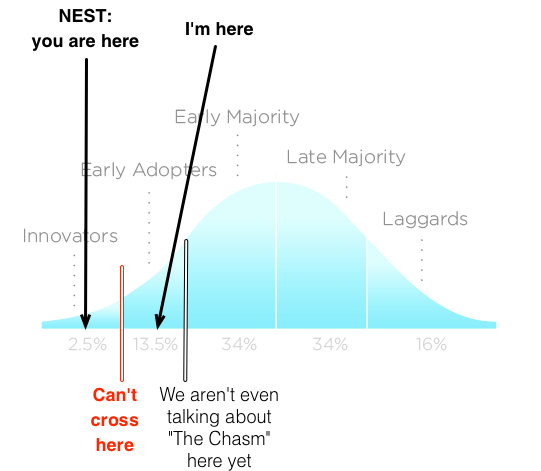I’m a believer that good things can be made to happen with the Internet of Things, but we are still very, very far away from that, in spite of all the hype.
Exhibit A: visiting the hardware store to buy a new thermostat for my house. (Mine gave up this week after maybe 25-30 years of service.)
 Unsurprisingly, the most prominent display is the Nest Thermostat, for $249 plus tax. The store display gives me two reasons why I might want to buy it:
Unsurprisingly, the most prominent display is the Nest Thermostat, for $249 plus tax. The store display gives me two reasons why I might want to buy it:
- It is a “learning thermostat”
- It saves me money
It also looks pretty. I think “saves me money” sounds like a good idea. How? It says that it basically learns about my habits, and makes sure the heater is off when I’m not home. This sounds reasonable, till I start thinking about it. The trouble is: the different members of our family have different schedules, and not all of them are regular or predictable at all. Which leads to the inevitable conclusion: it’s highly unlikely the Nest thermostat will learn something that is actionable, and if it does, it might very well have learned the wrong thing (“No, this week is entirely unlike last week.”) Chances are that this feature will not help me, and perhaps proactively get in the way.
How does it learn? Through various sensors that are part of the thing. The trouble here is: if I bought it, the thermostat would be located in the hallway on the first floor. Even if the sensors can look around the corners (I don’t know. Do they?) they cannot look behind closed doors, and certainly not in the bedrooms upstairs where teenagers tend to hide out. This sounds like another headache. Unless it has good and fairly complete data, it cannot produce good results, regardless how clever it is.
It also has Wifi, so I can control it from far away. Helpfully, Honeywell has a display right next to the Nest where they show why WiFi is cool. I should have taken a picture, but basically it’s the photo of a middle-aged guy, reclining in a beach chair at the beach, holding his smartphone, and changing the temperature of his house from the beach.
Really. Image you are at the beach, and you are having a good time (he smiles, in the photo). Obviously, all you can think of then is changing the temperature of the house that you left to go to the beach to have a good time at. The house that you are currently not in, but that other people like your wife or kids might be in, who may just possibly have an opinion about what the temperature of that house they are in should have. Which you obviously don’t know about, but you will hear about, when you return home, after your fun time at the beach. I can only think of a single reason why anybody would ever do this, and that is to impress some other middle-aged dude with the “but I have a WiFi thermostat and you don’t” argument.
I’m a geek, I appreciate smart technology, and love beautiful design, but I cannot for the life of me think what value that $249 piece of beauty would provide to me that I would actually appreciate. Applying Crossing the Chasm, I think this is where Nest, and consumer IoT are in general:
The problem is that with this kind of product, as beautiful as it is, crossing even into visionary buyers territory is essentially impossible. Which is probably the real reason Nest sold to Google.
The sad thing is that there are so many consumer use cases that would actually make sense to the next category of customers such as me. For example, something that only occurred to me today: instead of all the motion sensor machinery that cannot really work for situations such as mine, have a pollen/dust sensor. Then, have the thermostat retrieve the pollen report for the zip code, and run just the fan accordingly to get the pollen count in the house down. If it doesn’t work, prompt the user to replace the air filters in the house. That would be something I would pay $249 for, and that would use that WiFi thingy for something useful!
P.S. Before you ask: I decided to buy the cheapest digital thermostat they had on offer. It will do just fine, until I take the $249-$24 = $225 that I saved, and build myself the thermostat I actually want myself, using a BeagleBone Black, Raspberry Pi or something like that.

Comments
2 responses to “The consumer #IoT is mostly gimmicks today”
[…] which can lead to quite some frustration for the users – there is a great post on this by Johannes Ernst about the Nest thermostat. I fully agree that this is an easy hard […]
The consumer IoT is mostly gimmicks today http://t.co/gbnEM9nyU3